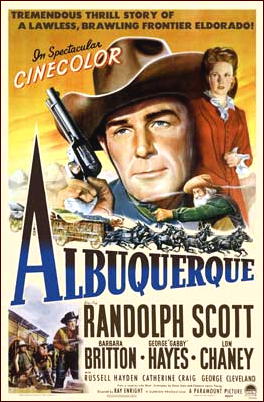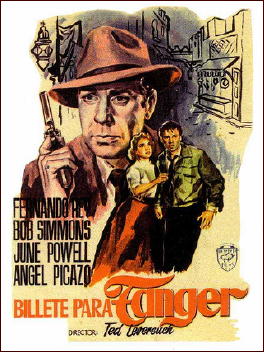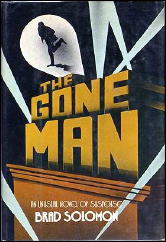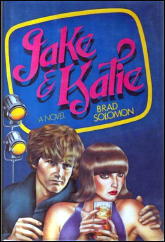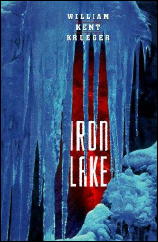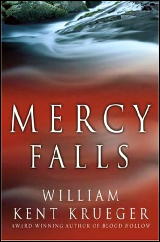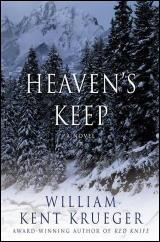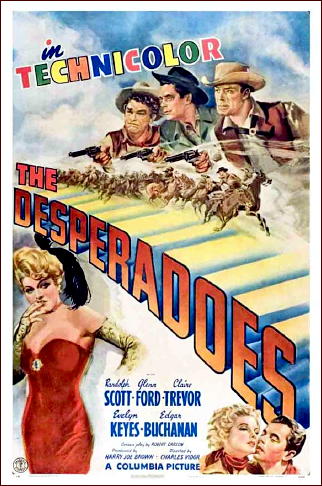May 2011
Monthly Archive
Sat 21 May 2011
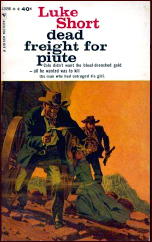
ALBUQUERQUE. Paramount Pictures, 1948. Randolph Scott, Barbara Britton, George “Gabby†Hayes, Lon Chaney, Russell Hayden, Catherine Craig, George Cleveland. Based on the novel Dead Freight for Piute, by Luke Short. Director: Ray Enright.
I don’t know whether the Luck Short novel this above-average technicolor Cinecolor movie is based on takes place in Albuquerque or not, but I suspect it doesn’t, since Piute is in Utah (or California) and therefore not particularly close (as the crow flies) to the titular city in New Mexico using anyone’s map, including Google’s.
The people who made this movie tried to dress it up a bit. Some of the various background settings appear Spanish in origin, such as one scene in particular that takes place on a Sunday morning with worshipers entering a Spanish chapel in their Sunday best finery. Otherwise the town the story takes place in could have been any other place in the West. They all look alike to me, anyway.
Randolph Scott has lead billing, and he’s definitely the star. He plays Cole Armin, who comes to town to work for his uncle John (a not so genial George Cleveland), who owns most of the freight contracts in the area, but when Cole discovers how crooked his uncle is, he goes to work for the competition instead, a brother and sister team played by Russell Hayden and Catherine Craig.
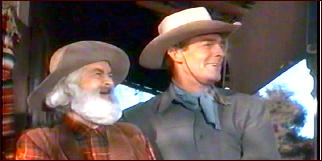
Second-billed Barbara Britton doesn’t show up until at least half the film has gone by, but perhaps she had a good agent to speak up for her. Which is not to say that she doesn’t have an important role. She also comes to town originally to work for John Armin, this time in an undercover capacity; which is to say that her job is to spy on the Wallaces for him.
With more plot to the tale than is usual – compared, that is, to your typical Rex Allen film, for example – there are a few twists and turns to the plot to come, with the whole story ending with a hair-raising trek down a mountain in a pair of freight wagons in an effort to win a new mining contract.
Which not so incidentally makes Dead Freight to Piute a better title, if you were to ask me, and yes, I know it’s too late now. But at least maybe the people who made the film did stick to the novel at least a little bit.
Seeing this movie in color was nice, and Gabby Hayes plays his usual colorful sidekick to the hilt. It’s Randolph Scott who’s the star attraction, though, and he’s given plenty to do to prove it.
Thu 19 May 2011
That muscle in my hip has healed, but it laid me up a long time (the better part of six weeks) and it’s been difficult to catch up. There are all kinds of things that ought to have been done in the meantime, and weren’t.
I was away from the computer most of yesterday, for example, and today it looks like more of the same. Besides the usual slew of reviews, there are lots of articles and other projects in the works, but I’m holding off on them until there’s time to do them and do them right.
I also owe a lot of people replies on emails that I’ve gotten since the end of March, when all this started, including maybe yours. My apologies for that. I’ve let too many things slide for far too long. All I can do is promise to do better. As soon as I can!
Tue 17 May 2011
TANGIER ASSIGNMENT. Rock Pictures, 1955. Filmed and originally released in Spain as Billete para Tánger. Robert Simmons, June Powell, Fernando Rey. Director: Ted Leversuch.
Everyone else in the cast appears to be Spanish, and as such, all of them are unknown to me. Even of the three of those above in leading roles, the only one I might have seen in a movie before is Fernando Rey.
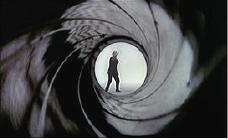
I’ll take that back. Bob Simmons, who plays an international undercover agent named Valentine in this film, I have seen many times before and so have you.
He was mostly a stunt man over his lengthy movie-making career (1939-1985), including long stints doubling for Sean Connery in many of the James Bond films. He was, in fact, the figure you saw in opening gun-barrel sequences of the first three of them.
Tangier Assignment (to use the English title) was filmed on location, either in Tangiers or outlying areas of Morocco, which means that (A) the settings are authentic, and (B) it really ought to have filmed in color. So far all to the good, but let’s put it this way. I am trying to say something positive about the story, but … it’s not easy.
Not that it’s terrible, exactly, and I’ll get back to that, but the story itself is awfully ordinary if not outright dull. Valentine is in Tangiers on the trail of some smugglers, but when he enters the small apartment of the man he is to contact there, he finds him dead on the floor, with a knife in his back. You might think that as far as the next step is concerned, calling the police, he is going to be in trouble, but (and this I concede is a surprise) the local police inspector (Fernando Rey) is amiable, friendly and understanding.
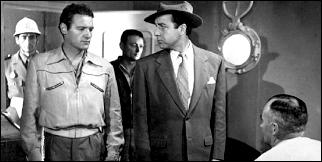
Which means he takes the killing on his turf totally in stride, even when (no surprise) they go back to the apartment to find … no dead body on the floor.
June Powell, who made one other movie besides this one (and one episode of one British TV show, is a nightclub singer who attracts Valentine’s attention and seems to tag along on some of his forays along the coast to find spots (caves) the smugglers might be using as a base of operations – the obligatory female role, you might say, and you might be right.
According to IMDB, and here is where a big problem with the story may lie, the film is supposed to be some 80 minutes long. The copy I have, on a collector-to-collector DVD, barely makes it much over 60. This may explain why, even with a brief burst of action at the end, the primary bad guy is a guy we’ve barely seen before.
I think some intervening material may have gotten chopped out, perhaps to fit a time slot at some time or another on TV. And if so, and this is pure supposition, of course, I’d rather they had cut some of the early musical numbers, of which there are more than one, rather than story.
But to get back to the good, though, and I’ve been sitting here at the keyboard long enough to remember to tell you this, Bob Simmons is a wonder. He is one of most active undercover agents I have ever seen. He leapfrogs over his opponents, literally, jumps out windows, makes flying leaps over walls, vaults fences, jumps down terraces, then two at a time, somersaulting as he falls before dashing off, with none of the large cast of villains able to follow, totally winded if not seriously injured in their endeavors. Marvelous!
Tue 17 May 2011
THE BACKWARD REVIEWER
William F. Deeck
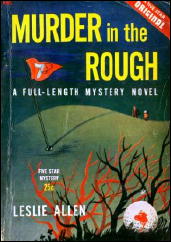
LESLIE ALLEN [HORACE BROWN] – Murder in the Rough. Five Star Mystery #45, paperback original, digest-sized, 1946.
In Napoleon B. (which may stand for “Buttercup,” but probably doesn’t) Smith’s only case, he apparently kills a slightly dotty old lady during a golf game when one of his drives, as is the fate of most of them, hooks into what is known as Hell’s Half Acre. Only sometime later does Smith conclude that he was not really responsible and that a murderer was on the course that day.
A sort of active and crass Nero Wolfe, Smith is a former policeman who uses his weight and bad manners as aids in his investigations. However, he also employs brains, which are not puny, and a literary background that is unexpected. Leslie Allen, Smith’s Watson [or Archie], reluctantly takes care of the dogsbody work.
It is to be hoped that Leslie Allen the character and alleged writer is a better stylist than Leslie Allen the author. Still, the creation of Smith is something of an accomplishment.
— From The MYSTERY FANcier, Vol. 12, No. 3, Summer 1990.
Bibliographic Data: Under his own name Horace Brown was the author of two other crime novels included in the Revised Crime Fiction IV, by Allen J. Hubin:
BROWN, HORACE. 1908-??
Whispering City. Streamline, 1947.
The Penthouse Killings. Newsstand Library #17A, 1950; reprinted as The Corpse Was a Blonde, Boardman, UK, 1950.
Whispering City was a novelization of the Canadian film of the same name starring Paul Lukas, Mary Anderson and Helmut Dantine. It was released in the US as Crime City (1947).
Tue 17 May 2011
BRAD SOLOMON – The Open Shadow. Summit Books, hardcover, 1978. Avon, paperback, 1980.
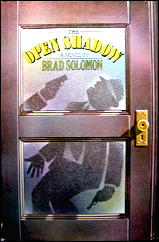
The private eye team of Thieringer and McGuane is as quietly competent as they come, most of the time. The only difference is that while Thieringer’s name is Fritz, McGuane’s is Maggie. They’re also both as tough as they come, so how’s anyone going to convince her that detective work is no job for a lady, if no one has by now?
Besides having to convince a reluctant client to hire them to protect himself from a kid with threats and a gun, Thieringer finds himself nursing along a youthful new assistant who may or may not work out. It’s a rough business.
As a specimen of the hard-boiled school, this is closer to Hammett than Chandler, the added plus being some refreshing humor that stays just this side of parody. Promising.
— Reprinted from The MYSTERY FANcier, Vol. 3, No. 6, Nov/Dec 1979 (very slightly revised). This review also appeared earlier in the Hartford Courant.
Bibliographic Comments: In spite of the promise I saw in the Thieringer and McGuane team-up, there never was a followup case for the PI twosome. Brad Solomon, in fact, wrote only three detective or crime fiction novels in the late 1970s, then seemingly disappeared from our field for good. From the Revised Crime Fiction IV, by Allen J. Hubin:
SOLOMON, (Neal) BRAD(ley).
The Gone Man (n.) Random 1977.
The Open Shadow (n.) Summit 1978.
Jake & Katie (n.) Dial 1979.
The hero of record in The Gone Man was Charlie Quinlan, an actor who turns to PI work to make a living. Bill Crider reviewed the book here on his blog, where there’s also a link to Ed Gorman’s blog, where Dick Lochte posted a list of his “Top 20 PI Novels,” which includes The Open Shadow. The company’s not bad there, either, what with Chandler, Hammett, Macdonald, Parker, Ellin and Estleman among the competition.
Bill also reviewed Shadow on his blog. Look for it here.
As for Jake & Katie, I don’t believe it did very well. There are only 10 copies offered for sale on ABE, for example, compared to 80 of The Gone Man and 60 of The Open Shadow. It’s described as a novel on the cover, but one seller calls it a “Hollywood mystery.” Yet another goes into considerable detail:
“Jake isn’t making it in Tinseltown. He meets Katie in a bar, and his life changes dramatically. Katie is young, beautiful, charismatic. when she moves in with Jake, she takes possession of his life . transforms it, getting him the roles he’s been looking for. Jake begins to feel that he’d be nothing without Katie, and it terrifies him. Soon he realizes that he really knows very little about the woman he’s living with. Why does she have such extreme mood swings? Why does she tell conflicting stories about her past? What does she want from him and how far is she prepared to go to get it?”
There is the briefest amount of biographical data on Brad Solomon in Contemporary Authors, and nothing to suggest why these three books were all there were.
Mon 16 May 2011
REVIEWED BY BARRY GARDNER:
AARON ELKINS – Old Scores. Chris Norgren #3. Scribner’s, hardcover, 1993. Fawcett Gold Medal, paperback, 1994.
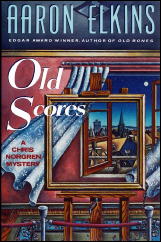
One thing about Elkins, he picks widely varying specialties for his series characters. Though he’s best known for his “bone doctor” series about Gideon Oliver, the Norgren books seem to be picking up speed. Chris Norgren is curator at the Seattle Art Museum, and who’d have thought the world of acquisitions would be so hazardous?
A famous French collector wants to give the museum a Rembrandt — great, hein? Well, maybe. There are a couple of catches: the painting has no provenance, and no scientific tests will be allowed.
Chris’s director wants him to go to France and make an accept/reject decision. Chris wants to reject it out of hand, but goes anyway, at the cost of some discombobulation to his already shaky love life.
Things are even weirder than expected in France, the situation turns nasty, and murder is done. Well, hell, what did you expect?
I don’t believe for a minute that any museum would even consider accepting a master painting without provenance and/or testing, but what do I know about museums? Aside from that, this is the kind of entertaining tale I’ve come to expect from Elkins.
I like Norgren as a character, and find the artistic background interesting and edifying. Elkins tells a good story, and creates a good set of supporting characters. His stories fall somewhere between cozy and hard-edged, and while I don’t think anyone would call them memorable, they provide an entertaining read.
— Reprinted from Ah, Sweet Mysteries #7, May 1993.
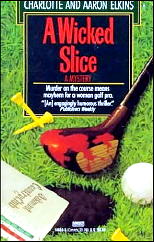
Editorial Comments: In spite of Barry’s feeling that Elkins’ Chris Norgren series was catching on, this was the third and last of his recorded adventures.
The Chris Norgren series —
1. A Deceptive Clarity (1987)
2. A Glancing Light (1991)
3. Old Scores (1993)
As of this month’s publication of The Worst Thing, there are seventeen Gideon Oliver books. Aaron Elkins’ wife Charlotte has been his co-author with five books in their Lee Ofsted series. The latter is a lady professional golfer; her first appearance was in A Wicked Slice (1989).
Sun 15 May 2011
IT IS PURELY MY OPINION
Reviews by L. J. Roberts
WILLIAM KENT KRUEGER – Vermilion Drift. Atria, hardcover, September 2010; trade paperback, June 2011.
Genre: Private eye. Leading character: Cork O’Connor; 10th in series. Setting: Minnesota.
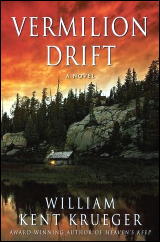
First Sentence: Some nights, Corcoran O’Connor dreams his father’s death.
Max Cavanagh owns several mines, one of which is being studied by the Department of Energy as a possible site to store nuclear waste. In addition to protests causing Cavanagh worry, his sister, Lauren, has gone missing.
Cork, hired to find her, does so but she is not alone. He locates her body in, what had been a closed off section of the mine, among five skeletons. The five skeletons are those of women known as “The Vanishings†who had disappeared decades ago, and two of the bodies contain bullets fired from the gun of Cork’s late father.
I was recently involved in a discussion of prologues and how many of us are either annoyed by them or ignore them completely. It takes a writer as skilled as Krueger to write a prologue which contains an important thread which runs through the story. The one in Vermilion Drift is not a prologue to ignore.
Krueger has become one of my favorite authors. His skill with description take what could be a fairly ordinary scene, but instead comes alive with clear, visual images. We are able to go where the author takes us and be a part of that which is described to us.
Even from those scenes where we might prefer to look away, we can’t. That doesn’t mean he is graphically violent; he’s not. It is more that we feel the emotion of the scene and, thereby, understand it.
Because I read first for character is another reason why Krueger’s writing appeals to me. He creates dimensional, interesting, relatable characters. I’ll admit I wasn’t particularly happy with the events of the previous book, Heaven’s Keep, but the transition to this book has been very effectively and tastefully handled and I now understand the purpose of those events.
Cork’s heritage is half Irish, responsible for his impatience and occasional anger, and half Ojibwa, which connects him to the people on the reservation, Indian history, and my favorite character Henry Meloux. It also provides the link to the mystical element in each book.
Before you walk away saying “I don’t like woo-woo,†wait. Mysticism and the spirit world are part of the Indian culture. They are also part — along with several other themes including that of what do we really know of our parents and the definition of evil — of what takes this book, and this series, beyond the normal and elevates it into something that makes you stop, think and consider.
Krueger is a very fine author who knows how to create characters, write dialogue, set a scene and, most of all, develop a plot. The story continually builds upon itself. It’s a twisty road filled complete with suspense, emotion and startling revelations.
I despise the cliché of “If you’ve not read this author yet, read him now,†yet that is the way I feel. Even if you don’t, be assured I shall be reading his next book as soon as it comes out.
Rating: Excellent.
The Cork O’Connor series —
1. Iron Lake (1998)
2. Boundary Waters (1999)
3. Purgatory Ridge (2001)
4. Blood Hollow (2004) Anthony award, Best novel, 2005.
5. Mercy Falls (2005) Anthony award, Best novel, 2006.
6. Copper River (2006)
7. Thunder Bay (2007) Anthony nominee, Best novel, 2008.
8. Red Knife (2008) Barry & Anthony nominee, Best novel, 2009.
9. Heaven’s Keep (2009)
10. Vermilion Drift (2010)
11. Northwest Angle (2011)
Sun 15 May 2011
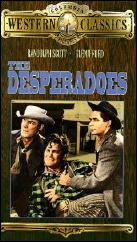
THE DESPERADOES. Columbia Pictures, 1943. Randolph Scott, Claire Trevor, Glenn Ford, Evelyn Keyes, Edgar Buchanan, Guinn “Big Boy†Williams, Raymond Walburn, Porter Hall. Based on an original story by Max Brand. Director: Charles Vidor.
Randolph Scott and Claire Trevor were the bigger names at the time, and they’re listed first in the credits, but neither of the two contributes nearly as much to this western extravaganza as do stars number three and four, Glenn Ford and Evelyn Keyes.
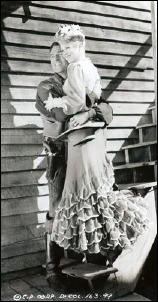
Glenn Ford, who plays Cheyenne Rogers in the film, was being groomed as a star at the time. The same path was envisioned for Evelyn Keyes, who was married then to director Charles Vidor, but as pretty and talented as she was, most of her films were of the B-variety. On the other hand, Glenn Ford, who was a very young 27 in 1943 – and looks it – did go on to many bigger and better things.
Cheyenne is a gunfighter hired by Evelyn Keyes’ Uncle Willie (Edgar Buchanan) to rob the local bank – unknown to her, of course – while Randolph Scott is the local sheriff who has a fatherly interest in Keyes. Maybe more, but he steps aside without a fuss if he did when Cheyenne comes along – the latter is a friend of his, as it turns out, even though they are on opposite sides of the law.
As for Claire Trevor, she’s the owner of the local gambling palace – and a very sumptuous one, as far as the usual standards of small western towns are concerned. They may be more going on in the back rooms than could be let on in a movie made in 1943. She’s also in on the plot to rob the bank, but if her part hadn’t been written into the screenplay, nobody would have noticed.
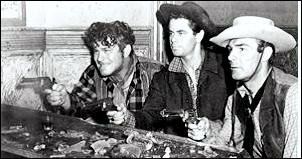
There is a lot of action in The Desperadoes, including one of the wildest wild horse stampedes I have ever seen in a movie, clear through Red Valley [Utah]. Of course some fool decides he has to run across the street from one sidewalk to the another just before the horses run through, but I guess every town has fools like that. (He makes it.)
Personally, I’d have liked to have seen more of Randolph Scott than Glenn Ford, who seems too young (see above) to be a wanted man with a reputation, even if wrongly accused, and awfully unsure of himself as an actor. Evelyn Keyes, though, is very pretty in either a calico dress or a western shirt and blue jeans. Even so, I’m afraid I’d have to agree that she doesn’t have the onscreen catch-your-eyes-and-hold-them type of personality she needed, as much as I’d like to say otherwise.
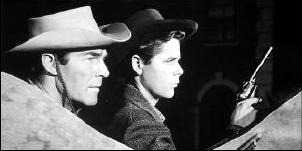
I mentioned a lot of action, but I haven’t mentioned (so far) the beautiful outdoor scenery, as befits a western film shot in color. (In fact, The Desperadoes was the first movie by Columbia to be released in color, a more than incidental fact that’s worthy of note.)
Incongruously, though, there is more comedy in this film than seems appropriate; that is to say, the presence of Edgar Buchanan and Big Boy Williams, not to mention the saloon fight that all but destroys the place. It is also difficult to reconcile Edgar Buchanan’s crooked and outwardly befuddled Uncle Willy with the innocence of Evelyn Keyes’ character; they simply don’t mesh.
Sat 14 May 2011
REVIEWED BY WALTER ALBERT:
OUTLAWS OF THE ORIENT. Columbia, 1937. Jack Holt, Mae Clarke, Harold Huber, Ray Walker, James Bush, Joseph Crehan, Harry Worth, Bernice (Beatrice) Roberts). Director: Ernest B. Schoedsack. Shown at Cinecon 44, Hollywood CA, Aug-Sept 2008.
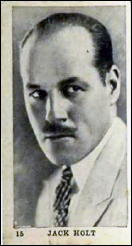
The program annotator was surprised to find Schoedsack directing this post-Kong quickie (only 61 minutes long). However, whatever its length and place in the hierarchy of Columbia’s releases in 1937, it proved to be an entertaining action film with engineer Holt, reluctantly returning to China to oversee drilling operations for oil, dealing with his problem-ridden brother (ostensibly in charge of the project) and attacks by a desert Warlord (Harold Huber), in the pay of a rival company.
When I was a wee lad, nobody was better than Jack Holt at projecting iron-jawed determination and bringing off what appears to be an impossible job. The movie zings along, anchored by his solid performance, a screening well-worth staying up for past my usual bedtime.
The notes claim that the film never made it to television syndication, so this was thought to be its first screening in some 71 years. Lucky Cinecon attendees.
Sat 14 May 2011
REVIEWED BY DAN STUMPF:
MURRAY LEINSTER – Operation Terror. Berkley F694, paperback original, 1962. Cover art: Richard Powers.

Next up, Operation Terror by that veteran boshmeister Murray Leinster. It’s easy to dismiss Leinster as a competent hack from the 60s, but there were all too few who could hack words so proficiently.
Operation starts off as Earth (or more precisely, Boulder Lake) is invaded by beings from another world, complete with flying saucer and paralyzer-beam, monitored helplessly by one of those competent, thoughtful, quick-thinking scientific type that we readers of sci-fi all imagined ourselves to be.
But as our hero sets about rescuing a distressed damsel and escaping the aliens, the invasion starts to seem more and more hokey, a development that steps up the suspense as he tries to counteract the alien rays, get to safety, warn the authorities, protect the girl and save the planet, all in the space of about a hundred-sixty tightly-packed pages.
These days when Sci-Fi has been replaced by multi-volumed tomes of “speculative fiction” we can but look back and admire the terse economy of writing like this.
« Previous Page — Next Page »


